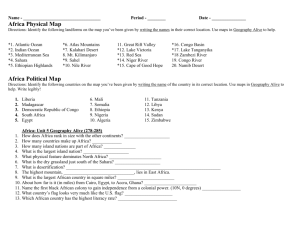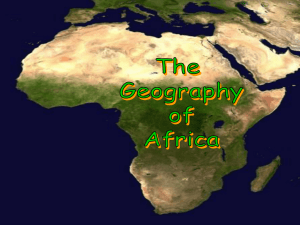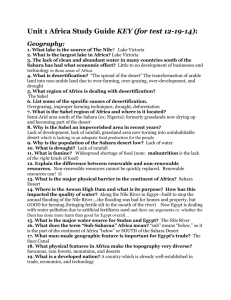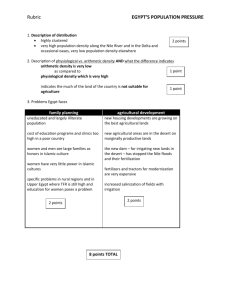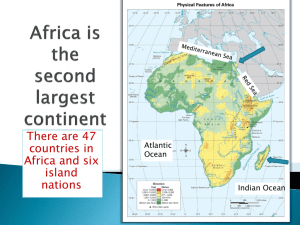Africa – 24 Chapters 21
advertisement
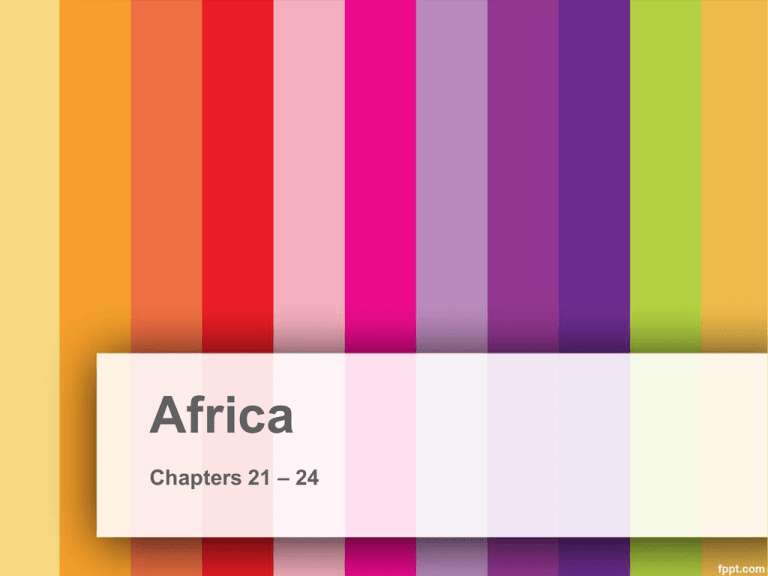
Africa Chapters 21 – 24 Modern Language Families Of Africa North Africa North Africa • North Africa stretches from the Atlantic Ocean to the Red Sea. • Egypt, Algeria, Libya, Morocco, Tunisia North Africa Natural Environment • Sahara is the world’s largest desert. • Covers 3.5 million square miles (roughly the size of the U.S.) • High winds and seas of sand called ergs Sahara Desert Sahara Desert Erg • In the Sahara, the Nile River runs north to the Mediterranean through Egypt. • This creates an arable (great for crops) region along the Nile. • Egyptian cotton has become a large part of the economy. • Most of Egypt, Algeria, and Libya are desert. • Oil and natural gas are located in all of North Africa. • Libya has the largest oil reserves North Africa History and Culture • Egypt – 3000 BC a great civilization grew along the Nile River and its Delta in Egypt – Polytheistic religion (belief in many gods) that believed gods controlled forces and elements of nature. – Kingdoms ruled by monarchs called Pharaohs. – Pharaohs were considered deities (gods) Gods Pharaohs – Built great pyramids as religious, burial monuments that showed wealth and status – Hieroglyphs – system of writing using symbols – Power weakened and foreigners (Phoenicians, Greeks, and Romans) began to control North Africa. Menkaure, Khafre, Khufu Khafre Giza, Egypt Ramesses’ Temple, Egypt Phoenician Empire – 650 B.C. Greek Empire 332 B.C. – 30 B.C. Roman Empire 117 A.D. • 600’s AD Arab armies conquered North Africa bringing in the Islamic culture and new technologies. • Most North Africans consider themselves Arab or Berber descendants. • Cities grew rich selling gold, ivory, spices, and slaves. • Until late 1800’s the Ottoman Empire ruled North Africa. Arab Conquests 600’s A.D. Ottoman Empire • Scramble for Africa – Invasion, occupation, colonization and annexation of African territories by European powers during the period of New Imperialism, between 1881 and 1914; looking for new sources of raw materials – 1884 Berlin Conference – colonization of Africa by European countries without regard to which ethnic group they were • 1882 Great Britain took control of Egypt in order to gain control of the Suez Canal. – Suez Canal – manmade waterway connecting Mediterranean Sea and Red Sea to shorten trade route from North Atlantic Ocean to Indian Ocean • 1952 a group of Egyptian military officers led revolution that won independence for Egypt. • 1962 Algeria gained independence from France through a war. • Libya became a socialist republic in 1969 following a military coup by Mu’ammar Gadhafi. • Arabic is the official language • Most North Africans are Muslims, but Jewish and Christian minorities exist. Mu’ammar Gadhafi 1969 – 2011 North Africa Today • Morocco and other North African countries have taken steps to strengthen ties with Europe. • Oil and natural gas are the backbone of the Algerian and Libyan economies. • Agriculture is important to Egypt. • Libya is the only country in North Africa that does not have a strong farming sector. • Libya must import 75% of its food • Tourism is important to Egypt, Tunisia, and Morocco. • Islamic fundamentalists believe that government should be based strictly on Islam. West and Central Africa West and Central Africa Natural Environment • • • • • The Congo and the Niger are two of Africa’s major river systems and essential to their success. The Sahara desert extends into northern Niger, Mali and Mauritania. The Sahel is a semi-arid region along the southern edge of the Sahara. The Sahara Desert is slowly expanding southward (desertification) because of a combination of droughts and a growing population in the Sahel. The desert is encroaching upon the savannas (tropical grasslands). Niger River System Congo River System People in the Congo African Bush Elephant African golden wolf Cheetah Lion Leopard Nile Crocodile Chimpanzee Gorilla Sahel West and Central Africa History and Culture • Bantu – Nomadic people (moved to new places to find new resources for survival) who migrated out of West Africa around 1000 B.C.; spread and changed cultures as they went through the center of Africa to the east and south searching for new farmland • Great kingdoms ruled large areas because of nearby trading routes. – Ghana – 800’s AD; used camel caravans across Sahara Desert to export gold, iron, and slaves in exchange for highly prized salt, horses, cloth, swords, and books – Mali – 1200s replaced Ghana; the wealthy city of Timbuktu was an important trading city and helped to spread Islam. – Songhai – 1400’s – 1500’s; taken over by Moroccans in 1591 for financial benefits – New ideas, Arabic culture and Islam spread to this region among trade routes. Salt Caravan Timbuktu 1830’s Timbuktu Spread of Islam • 1400’s discovered by European explorers while searching for a water route to Asia. • Slavery – Labor demands in the world’s colonies changed focus of trade from gold to slaves. – Most slaves came from areas between what are now Senegal and Angola. – 1500’s – 1800’s Europeans and Africans traded at least 10 million slaves using the Triangle Trade Routes and the Middle Passage – This greatly changed the area in many ways. – Coastal states that traded slaves for guns got upper hand over interior states. – It disrupted entire societies and families. – By the mid 1800’s, the slave trade was coming to an end. Modern slavery takes many forms: • human trafficking • forced labor • slavery or slavery-like practices • debt bondage • forced marriage • sale or exploitation of children including in armed conflict • Europe was industrializing and wanted more minerals than they could produce at home. • During this time, West and Central Africa quit subsistence farming (just enough for your family) and began working for wages. • In 1957 Ghana became independent; by 1976 all African countries in this region were independent. • Because rival ethnic groups had to share power, this caused serious political rivalries in the new countries. West and Central Africa Today • Societies are very diverse. • Three major cultural influences – African cultures – European cultures – Islam • Most of the languages spoken here belong to the Niger-Congo language family. • English and French are the lingua francas (common language) of much of Africa and are still used frequently today. • Islam is the main religion in the Sahel, however many Christians live in the south. • Region of developing countries (low economic status/low literacy rate/low life expectancy and high unemployment/high disease rate). • Education – Main obstacle is poverty. – Children are needed for work and to care for younger siblings. – Small percentage finish high school. Few go to college. – Many do not have the opportunity to learn reading and writing. • Most people of the region produce their own food (subsistence farming). • Customs and traditions differ from ethnic group to ethnic group. • Gabon is one of the richest countries in Africa because of its oil reserves. • West and Central Africa have dual economies in that some goods are produced for export to wealthy countries and some are produced for locals. Gabon • Nomadic herds have been forced into stationary ranches and have led to soil erosion and overgrazing. • Lack of factories leads to exporting primary goods (crops) instead of secondary goods (products). • Most of these countries depend heavily on only a few major exports. West and Central Africa Challenges • Growing population and lack of infrastructure and food sources to support it. • Rapid urbanization leads to housing shortages. • Many live in shantytowns without electricity or water. Shanty town or Slum • War and conflicts (Democratic Republic of the Congo, Liberia, and Sierra Leone) • Destruction of their natural environment such as the rain forests in the Congo for lumber and clearing grasslands for farming • HIV has spread rapidly East Africa East Africa Natural Environment • Nile River – Major river that flows northward through the Sudan. – Two sources: • The White Nile (from Lake Victoria and Albert) • The Blue Nile (starts in the Ethiopian highlands) • Weather is often unpredictable Lake Victoria White Nile Rapids Blue Nile Falls • Serengeti Plain has many safari animals such as giraffes, lions, wildebeest, and zebras Serengeti Plain Mt Kilimanjaro- Tanzania 16,001 ft Ngorongoro - Tanzania 2,000 feet deep 100 square miles • Tsetse fly keeps human populations away from the large savannas because it causes a disease called sleeping sickness that only affects humans. Uganda • Not rich in energy or mineral resources and most soils (dry lands) have too much salt and lime to be used. • Most valuable resource is scenery for tourists. Somalia Burundi East Africa History and Culture • Some of the world’s earliest artifacts are found in East Africa. • Little is known about East Africa’s early people because no written record was kept. • Arab traders began trading gold, slaves, and ivory in this region 1,500 years ago. • The Swahili language (mixture of Arab and African languages) developed during this period. • By the late 1800’s, European countries scrambled to claim territory in the region. • Ethiopia stayed mostly independent • Europeans created most of the major cities today and brought hospitals, ports, roads, and schools to profitable areas. • East Africa includes several hundred ethnic groups, but they can be organized into three categories according to language: – The Nilotic People (Nile area of the Sudan) – The Cushitic Speakers (Red Sea to the Horn of Africa) – The Bantu Speaker (Kenya, Rwanda, South Africa) • Most of the traditional religions of the area are animist. (They believe spirits reside in animals, trees, mountains, and waters.) • Christianity came to Ethiopia over 1,500 years ago. • Missionaries from the 1800’s through today have spread Christianity throughout this region. • Boiled sorghum (a grain that can withstand a drought ) was the main food of the region. sorghum • Every country of East Africa is a developing country • Subsistence farming is common. • Depending on the climate, the important crops are beans, corn, rice, sorghum, and wheat. East Africa Challenges • Drastic rise in population leading to widespread poverty. • High crime rates due to unemployment. • Unstable governments • Disease such as cholera, Ebola, malaria and AIDS kills thousands of East Africans every year. • Conflicts – Ethnic conflicts – Rwanda in 1994 the Hutu tried to wipe out the Tutsi. Thousands were slaughtered (genocide – killing of a race) – Somalia in the early 90’s different clans fought over control of grazing rights, ports like Mogadishu, and food. – Darfur in the western Sudan the Janjaweed, a militia group recruited from the tribes of the Abbala (camel-herding Arabs) have been fighting and killing the non-Baggara people (mostly landtilling tribes) of the region. – The World Health Organization (WHO) has estimated the killing between 50,000 and 450,000 since 2003. Tutsi Hutu Darfur Southern Africa Southern Africa Natural Environment • Between the coastal plain and the plateau is an escarpment (a steep face at the edge of a plateau) • Several major rivers flow across this region: – The Orange River (empties into the Atlantic/ source of hydroelectricity) – The Limpopo (Crocodile river, drains into Indian ocean) – The Zambezi (major source of hydroelectricity / Victoria falls located here) 5,604 ft wide 354 ft tall • The wettest area is the tropical rain forest region known as Madagascar (large island off coast) which is known for its biodiversity. • The Namib Desert is located in Namibia and has the world’s largest sand dunes. – Dry and lacks much life – Dew and fog are the most important sources of water. • Eastward is the Kalahari Desert where more plant and animal life can exist because it is not as dry. • The Kalahari merges into the veld. (African savannas/grasslands) • South Africa has many valuable energy and mineral resources. (oil, coal, gold, platinum, diamonds, copper) Southern Africa History and Culture • 100 AD – migrant Bantu peoples were farmers and animal herders. Changed culture by knowing how to make tools. • In 1652 the Dutch set up a settlement at the Cape of Good Hope. Other Europeans followed suit. • Known as Boers (Dutch for farmers), they eventually came to think of Africa as their home and began to call themselves Afrikaners. Castle of Good Hope 1680 • Afrikaans – new language that combined words from the Dutch, African, German and Asian peoples who lived there • In the 1800’s the British took control of the area. This moved the Afrikaners inland so they could be independent. • From 1899-1902, the Boer War was fought in this region between the British and the Boer people over a desire to control mineral wealth (diamonds). Boer Encampment • In the end the British gained control of what is now South Africa. • Britain granted independence to most of its remaining colonies during the 1960’s • Both Angola and Mozambique battled communist regimes until the 1990’s. • In South Africa White Afrikaners continued to control the economy, political power, and owned most of the land. • Apartheid (separateness) – 1948 blacks in South Africa were denied political rights – Laws forced blacks to live in different areas and use different facilities than whites in South Africa – Nelson Mandela – key leader of reform movement (African National Congress) imprisoned in 1962 for his activities Apartheid South Africa – In 1990 South Africa finally began to change its politics and end apartheid Nelson Mandela was released from prison – In 1994 South Africa held its first free elections and Nelson Mandela was elected South Africa’s first black president. • Southern Africa’s cultural mix reflects its diverse history. • Today millions of Africans belong to Christian churches. Southern Africa Today • All of the countries in Southern Africa are classified as developing countries. South Africa is sometimes considered middle income. • Mozambique is one of the poorest countries in the world and relies on farming. • Farming, whether market economy or subsistence, is the most widespread economic activity. • Minerals and oil are becoming increasingly important to the economics of southern Africa. • South Africa produces more gold than any other country. Some mines are 13,000 feet below ground. • Botswana is one of the world’s leading producers of diamonds and has the fastest growing economy in Africa. • Southern African countries are very dependent on a few primary exports. This can be risky because of price fluctuations. • Many tourists travel to the wild game parks of Botswana, Namibia, South Africa, and Zimbabwe to see African wildlife. • Greater Johannesburg is the largest urban area in southern Africa with 4 million people Southern Africa Issues and Challenges • Poverty is the most serious problem facing southern Africa. • Droughts and floods often strike (More than 1 million people were uprooted in Mozambique due to flooding in the year 2000.) • A decrease in air quality in the large cities in a problem. • In some countries in southern Africa more than ¼ (25%) of the population is infected with HIV. • In Botswana, 36% of adults have HIV. • Because of AIDS, the life expectancy in these countries is rapidly falling. • Attempts are being made to educate the public by the South African government, missionary groups, and private charitable organizations.
